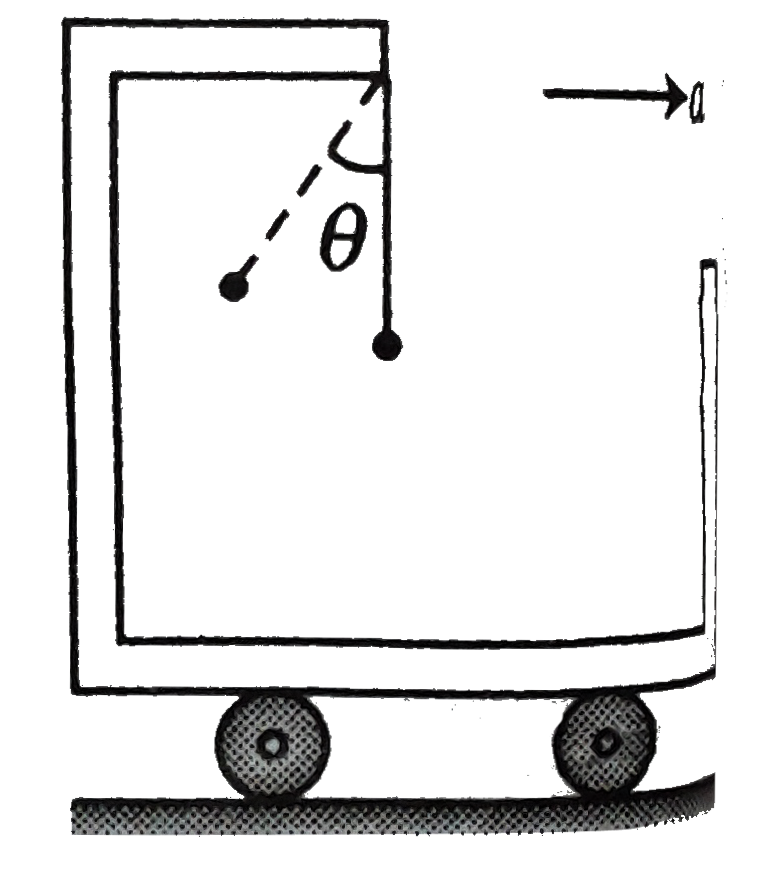A trolley has a simple pendulum suspended from a frame fixed to itsa desk A block B is in contact on its vertical and The trolley is on horizontal rails and acceleration toward the right such that the block is just orevented from falling The value of coefficient of friction between A and B is 0.5 to the vertical is

tan−1(12)
tan−1(3)
tan−1(√2)
tan−1(2)
The correct Answer is:D
In the free body diagram of B

N=mBa …(i)
f=mBg
μN=mBg…(ii)
From Eqs (i) and (ii)
a=gμ=20ms−2
FBD of bob
Tsinθ=ma…(iii)
Tcosθ=mg...(iv)
From Eqs (iii) and (iv)
tanθ=ag⇒θ=tan−1(2)
Topper's Solved these Questions
- NEWTON'S LAWS OF MOTION 2Book:CENGAGE PHYSICSChapter:NEWTON'S LAWS OF MOTION 2Exercise:Multiple Correct
Explore 2 Videos
- NEWTON'S LAWS OF MOTION 2Book:CENGAGE PHYSICSChapter:NEWTON'S LAWS OF MOTION 2Exercise:Linked Comprehension
Explore 52 Videos
- NEWTON'S LAWS OF MOTION 2Book:CENGAGE PHYSICSChapter:NEWTON'S LAWS OF MOTION 2Exercise:Subjective
Explore 21 Videos
- NEWTON'S LAWS OF MOTION 1Book:CENGAGE PHYSICSChapter:NEWTON'S LAWS OF MOTION 1Exercise:Integer
Explore 5 Videos
- PROPERTIES OF SOLIDS AND FLUIDSBook:CENGAGE PHYSICSChapter:PROPERTIES OF SOLIDS AND FLUIDSExercise:INTEGER_TYPE
Explore 2 Videos
Similar Questions
A trolley A has a simple pendulum suspended from a frame fixed to its deck A block B is in contact on its vertical side. The trolley is on horizontal rails and accelerates towards the right, such that the block is just

prevented from falling. If the value of coefficient of friction between A and B is 0.5 find the value of the inclination of the pendulum to the vertical.
View SolutionA block is pressed towards a vertical wall using a horizontal force equal to n times its weight which prevents the block from sliding down.Then coefficient of static friction between the block and the wall is?
View Solution
Knowledge Check

A rough vertical board has an acceleration a so that a 2 kg block pressing against it dows not fall. The coefficient of friction between the block and the board should beA>gaB<gaC=gaD>agA hollow cylinder of radius R rotates about its axis which is vertical. A block remains in contact with the inner wall if the frequency of rotation is f hertz, but falls at lower frequaencies. The coefficient of friction between the block and the cylinder is
Ag2π2f2RBg4π2f2RCgπ2RD2gπ2f2RA block of mass m is in contact with the cart C as shown in The coefficient of static friction between the block and the cart is μ The acceleration a of the cart that will prevent the block from falling satisfies
 .Aa>mgμBa>gμmCa>gμDa<gμ
.Aa>mgμBa>gμmCa>gμDa<gμ
A block of mass 2kg is placed on a trolley of mass 20 kg free to move on a frictionless floor. What are the frictional force, accelerations of the block and trolley if the block is pulled by a force of 3 N ? The coefficient of friction between block and trolley is 0.25. What will be the values of all three if the block is pulled by 8 N force ? At what value of the applied force will the bodies just tend to separate ?
[Hint : So long as the force applied does not produce the limiting frictional force the two will move with common acceleration. When the force applied exceeds that limiting value the block will move on the trolley with a different acceleration]
View SolutionA rectangular block is held against a vertical wall by applying a force of 200N normal to the wall. If the frictional froce just prevents the block from sliding down the wall, what is the mass of the block? (The coefficient of static friction between the block and the wall is 0.49)
View Solution
A massless spring of stiffness 400 N/m is fastened at left end to a vertical wall as shown in the figure I. initially block C of mass 2 kg and block D of mass 5 kg rest on horizontal surface with block C in contact with spring (But not compressiong it.) and the block D in contact with block C block C is moved leftward compressing spring by a distance of 0.5 m and held in place while block D remains at rest as shown in the figure. Now block C is released and it accelerates to the right towards block D the surface is rough and the coefficient of friction between each block and surface is 0.1 The block collide Instantaneously stick together and move right find the velocity of combined system just after collision.
View SolutionBlock A has a mass of 2 kg and block B has a mass of 20 kg if the coefficient of kinetic friction between block B and the horizontal surface is 0.1, and B is accelerating towards the right with a=2m/s2 , then the mass of the block C will be -

View SolutionA block A of mass 2kg rests on another block B of mass 8kg which rests on a horizontal floor. The coefficient of friction between A and B is 0.2 while that between B and floor is 0.5.When a horizontal floor F of 25N is applied on the block B the force of friction between A and B is
View Solution

